
Aucklanders wanting to make a splash in the sea might want to think twice with dozens of high risk swimming warnings in place across the region's beaches.
According to Auckland Council's Safeswim website, over 50 of Auckland's beaches have a "high risk" of illness from swimming.
Ten of those spots also include a long-term alert, where swimming is not advised with sampling showing water quality consistently fails to meet national guidelines.
The warnings come after bursts of torrential rain and storms battered Auckland over the weekend, putting stress on parts of the storm and wastewater networks.
City beaches including St Heliers, Judges Bay, Okahu Bay, St Marys Bay, Cox's Bay were considered "high risk" swimming areas for beach-goers.
On the North Shore, Long Bay, Cheltenham, Browns Bay, Bayswater, Narrow Neck, Milford South, and Mairangi Bay were also placed on the high risk list, along with a number of others.
Further South and East, the popular Maraetai, Eastern Beach, Farm Cove, and Kawakawa Bay were deemed high risk swimming spots.
North and South Piha Lagoon is on a long term alert, as well as Bethells Beach's lagoon.
/cloudfront-ap-southeast-2.images.arcpublishing.com/nzme/EGD6343NDFTNFYZEJN3FGIOVRM.jpg?width=779&height=519&mode=max)
Check before you swim. Photo / Sylvie Whinray
The red alert classification is triggered by a direct measure of faecal indicator bacteria, Enterococci, in the water.
It denotes a greater than 2 per cent chance of getting sick from swimming at a beach.
A black alert, which there are none of currently, indicates a "very high risk" of illness from swimming and means the water was directly contaminated by human faeces, and not just the Enterococci bacteria that could be from the gut of any animal.
According to the Safeswim website, their water quality forecasts take account of rainfall, wind, tide, sunlight and beach type.
They are built using high-frequency targeted sampling on top of historical monitoring results, and are underpinned by the best available meteorological data, including readings from rain radar and an extensive network of rain gauges.
Safeswim's forecasts are automatically overridden if sensors detect unpredicted events – like a wastewater overflow in dry weather – that are likely to cause a public health risk.
Safeswim is overseen by an independent panel of public health and water quality experts and is required to meet performance standards adopted from the United States Geological Survey (USGS).
Take your Radio, Podcasts and Music with you









